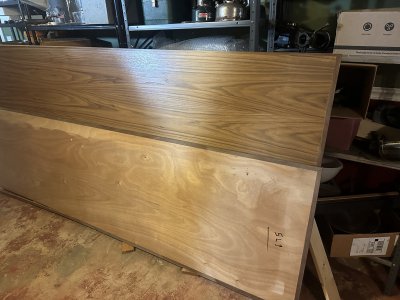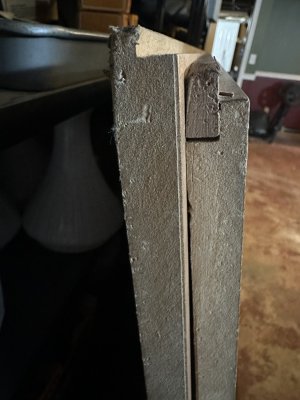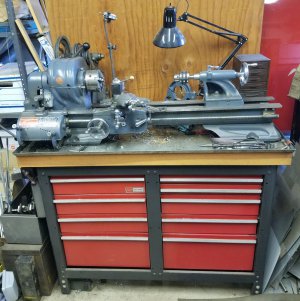I e built two dinning room style tables out of bowling alley wood. I learned that a bowling alley is not all maple. The first section is maple where you drop the ball about 10’ in it turns to pine in my case. Mine were glued but once you span a distance the glue separated. Then I had to reflux the whole top. Then getting all the oil and varnishes idk off was a true pain in the ass. If you use as a lathe top my recommendation would be make sure their glued and stable then I’d laminate a pc of plywood under it and glue the hell out of it.
-
Welcome back Guest! Did you know you can mentor other members here at H-M? If not, please check out our Relaunch of Hobby Machinist Mentoring Program!
You are using an out of date browser. It may not display this or other websites correctly.
You should upgrade or use an alternative browser.
You should upgrade or use an alternative browser.
How about bowling alley wood for a lathe bench top? I was
- Thread starter Quick Cal
- Start date
- Joined
- Jan 15, 2016
- Messages
- 58
So I have these sheets of stuff that I don't know what it is. I believe it is some kind of laminated particle board? I can't tell what the core material is, but it's laminated on both sides. It has a lap joint on each long edge for joining pieces together I guess? They are 4'x9' and 29''x9'. It has a slick surface on it for the top. One end has a finished edge, but the other end has been cut. I think they were big bench tops? Who knows?
Would I dare try to use this stuff? Maybe double it up? But if it is particle board I think it would just compress from the weight of the lathe wouldn't it?
Can you guys tell I'm not a wood worker,,,lol. After all. This IS a machinist forum,,,lol.


Would I dare try to use this stuff? Maybe double it up? But if it is particle board I think it would just compress from the weight of the lathe wouldn't it?
Can you guys tell I'm not a wood worker,,,lol. After all. This IS a machinist forum,,,lol.


- Joined
- Nov 25, 2015
- Messages
- 8,389
mdf is the core. Nope.
- Joined
- Jan 15, 2016
- Messages
- 58
That it was a no go. Just wanted to verify. Thanksmdf is the core. Nope.
- Joined
- Dec 9, 2021
- Messages
- 735

Forty years ago I rebuilt my Atlas QC42 and put it on a Craftsman workbench. I took plywood subfloor and glued two thicknesses together. I edged it with rectangular clear fir, glued in place. I had the local HVAC shop bend up some 22 gauge galvanized sheet into a chip pan with soldered joints. This keeps the drips from getting to the wood and makes it easy to clean out under the machine.
The only change I would make is to put 1/2" steel spacers under the mounting feet of the lathe in order to make it easier to clean out.
For a solid long lasting top I’d use 2x4’s. You could drill a hole every foot so when glued up you run threaded rod through the hole and tighten it up. Personally I would plane the glue sides then belt sand the top smooth. It would outlast you.
- Joined
- Nov 25, 2015
- Messages
- 8,389
me thinks he doesn't have a belt sander, or wood plane.For a solid long lasting top I’d use 2x4’s. You could drill a hole every foot so when glued up you run threaded rod through the hole and tighten it up. Personally I would plane the glue sides then belt sand the top smooth. It would outlast you.
- Joined
- Sep 1, 2018
- Messages
- 652
Find couple of free treadmills. Bigger the better. The walking boards are fiber core coated with black very slippery substance. I have couple over 1” thick Plus dc or 3 phase motors.
- Joined
- Dec 21, 2018
- Messages
- 1,829
Woodworker here. Framing lumber isn't dry and will move a lot while it goes from 19±% to 6 or 8%, in your house. If the annual rings are long gentle curves (looking at the end grain) the 2 x 12's will cup as they dry. Not good! Chose boards with the grain as near vertical to the faces as you can. They will stay flatter but will still shrink over their width. All wood will move until it reaches equilibrium with its environment. If the humidity in the room changes the wood will also. You can't stop it! Temperature has little effect other than affecting the absolute amount of water the air can hold. Framing lumber is usually "SPF" meaning it can be a mixture of spruce, pine & fir. If you are lucky you may find southern yellow pine, Strong heavy and hard especially after it fully dries. If there is a millwork shop near you they may carry it and will cut it to length for you. What they have will likely be random widths and be dried to 9-11%. Reasonably stable SYP. They will call it 8/4 or eight quarter (2" rough) Usually surfaced to 1 3/4" They can edge a piece for you also. I used to stock SYP so we could match the trim or flooring in old construction.
Whatever wood product you choose to use, treat both sides the same to prevent differential movement of the two faces and cupping. Saturating all surfaces especially the ends with a drying oil that you've mixed 1/3rd urethane oil based varnish in, gives a more durable finish than straight Danish oils like McFadden's or Watco. The finish will slow the exchange of moisture and reduce movement. Whatever finish you use it will become mared over time. Just part of its history.
Whatever wood product you choose to use, treat both sides the same to prevent differential movement of the two faces and cupping. Saturating all surfaces especially the ends with a drying oil that you've mixed 1/3rd urethane oil based varnish in, gives a more durable finish than straight Danish oils like McFadden's or Watco. The finish will slow the exchange of moisture and reduce movement. Whatever finish you use it will become mared over time. Just part of its history.

